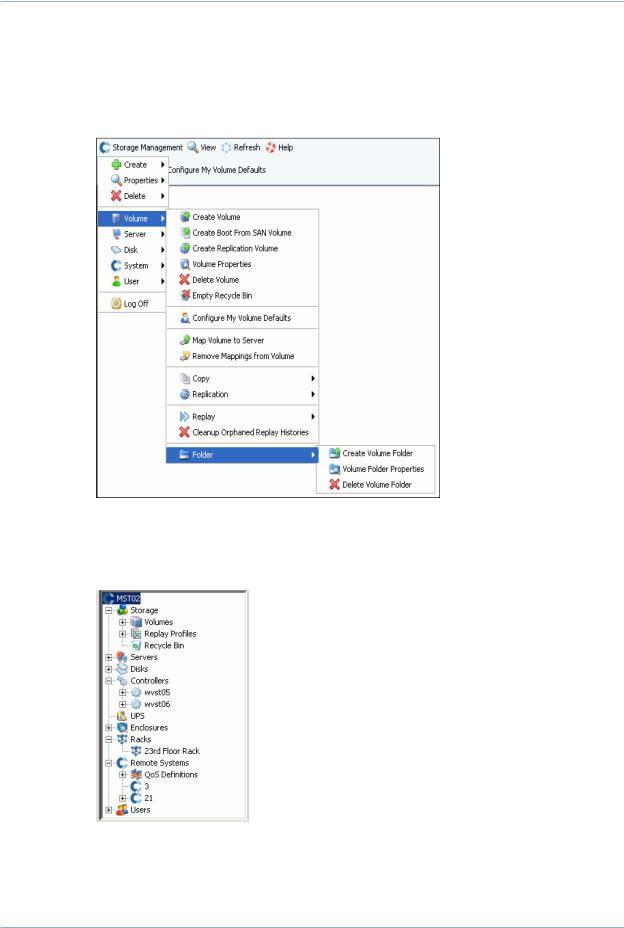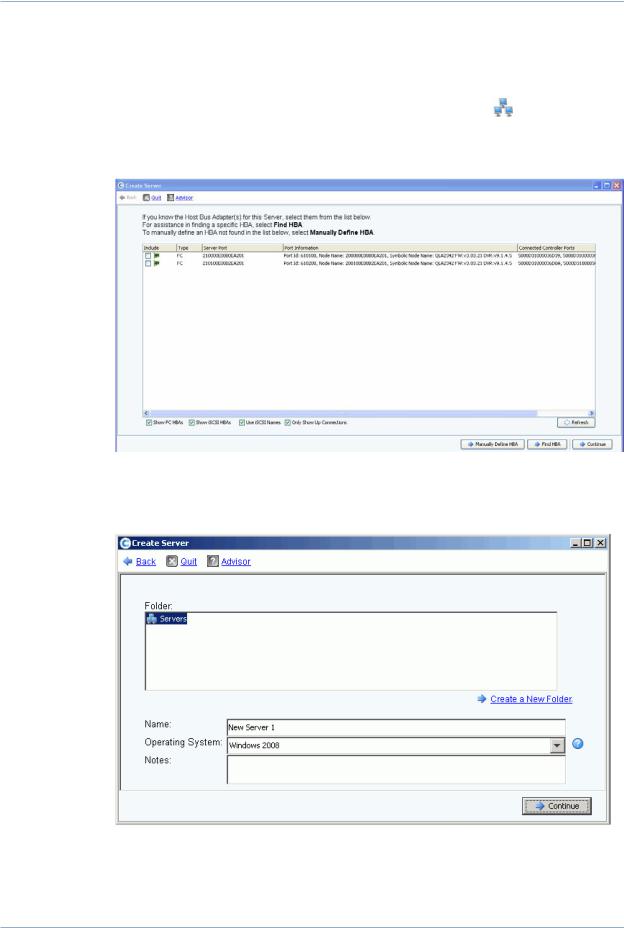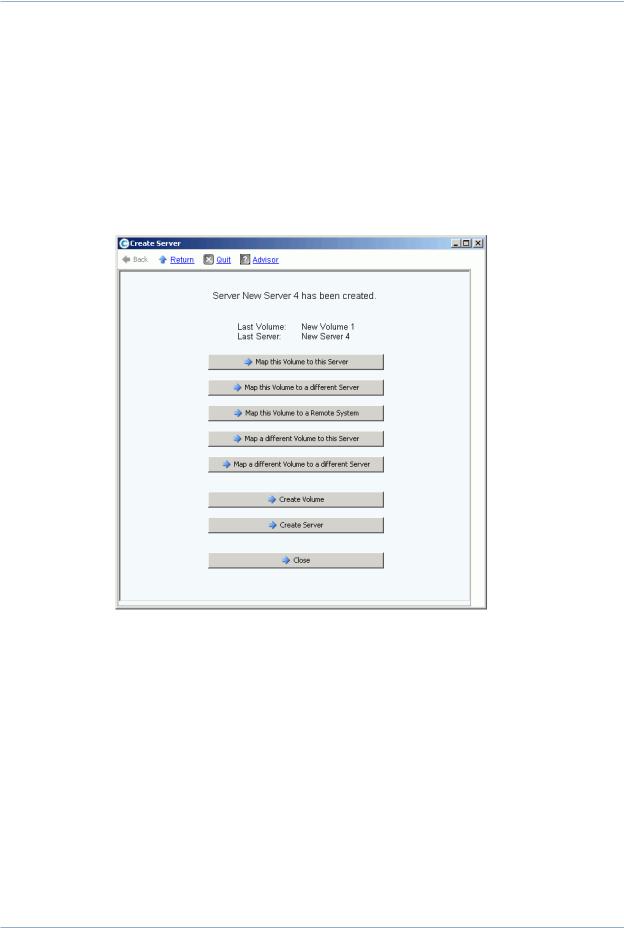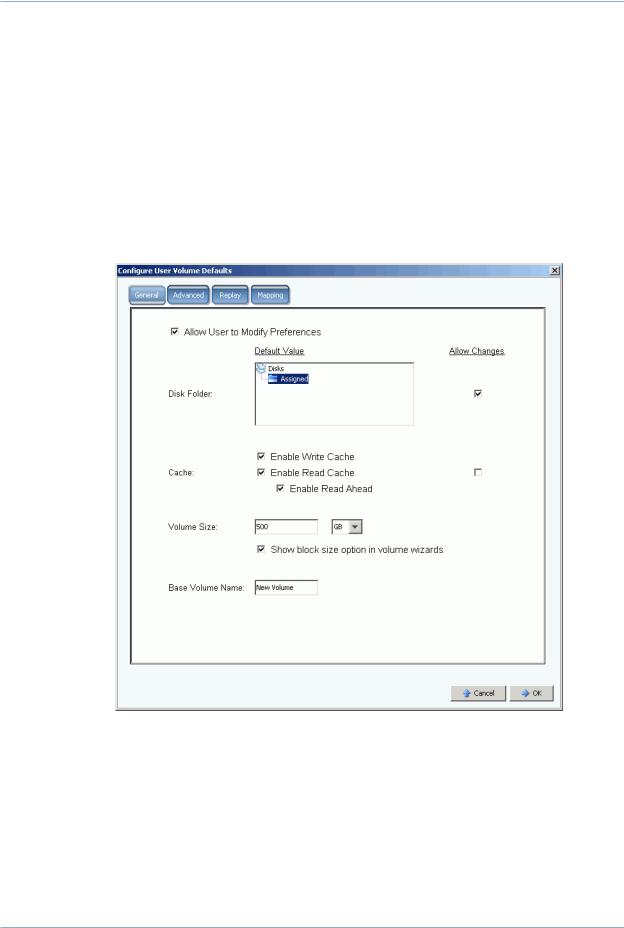Dell Compellent 40 User Manual

Storage Center 5.5
System Manager
User Guide

Storage Center System Manager 5.5 User Guide
680-019-009
Revision |
Date |
Description |
A |
03/16/11 |
Initial release for Storage Center 5.5.2 |
|
|
|
B |
4/12/11 |
Updated to include new locations for contacting Dell technical support and downloading |
|
|
product manuals and other editorial changes and corrections. |
|
|
|
Disclaimers
Information in this document is subject to change without notice.
Trademarks and Copyright
Trademarks used in this text: DellTM, the DELLTM logo, and CompellentTM are trademarks of Dell Inc.
Other trademarks and trade names may be used in this document to refer to either the entities claiming the marks and names or their products. Dell Inc. disclaims any proprietary interest in trademarks and trade names other than its own.
© 2011 Dell Inc. All rights reserved.

Contents
Preface
Purpose vii
Related Publications vii
Contacting Dell Support Services vii
1 Introduction
What’s New in this Release 2
Introducing the Storage Center System Manager 7
Navigation 12
2 Quick Start Guide
Introduction 16
3 Servers |
|
|
Introduction 28 |
|
|
Servers 29 |
|
|
Server Clusters |
32 |
|
Virtual Servers |
42 |
|
Common Server Commands |
45 |
|
Managing HBAs |
47 |
|
Managing Server Folders 52 |
||
Viewing Server Information |
54 |
|
Topology Explorer Server Functions 62 |
||
4 |
Volumes |
|
|
|
Introduction 66 |
|
|
|
Creating Volumes |
67 |
|
|
Mapping Volumes to a Server 73 |
||
|
Import Data to Lowest Tier |
80 |
|
|
Creating a Boot from SAN Volume 82 |
||
|
Modifying Volumes |
86 |
|
|
Managing Volume Folders |
91 |
|
|
Applying Replay Profiles |
95 |
|
|
Copy, Mirror, and Migrate |
97 |
|
iii

|
Viewing Volume Information |
100 |
|
|
|
|||||||
|
Recycle Bin |
108 |
|
|
|
|
|
|
|
|
|
|
|
Topology Explorer Volume Functions |
109 |
|
|
||||||||
5 |
Disks |
|
|
|
|
|
|
|
|
|
|
|
|
Introduction |
114 |
|
|
|
|
|
|
|
|
|
|
|
Viewing Tiers |
115 |
|
|
|
|
|
|
|
|
|
|
|
Adding Disks to a Storage Center System |
116 |
|
|||||||||
|
Configuring Storage |
120 |
|
|
|
|
|
|
||||
|
Rebalancing RAID |
122 |
|
|
|
|
|
|
|
|||
|
Managing Disks |
126 |
|
|
|
|
|
|
|
|||
|
Managed Disk Folders |
130 |
|
|
|
|
|
|||||
|
Importing from External Device without Replication License 133 |
|||||||||||
|
Non-Standard Storage Types |
138 |
|
|
|
|||||||
6 |
Controllers |
|
|
|
|
|
|
|
|
|
||
|
Introduction |
142 |
|
|
|
|
|
|
|
|
|
|
|
About Controller Virtual Ports |
143 |
|
|
|
|||||||
|
Viewing Controller Properties |
144 |
|
|
|
|||||||
|
Viewing Controller Status 146 |
|
|
|
|
|
||||||
|
Viewing FC Folders and Cards |
|
150 |
|
|
|
||||||
|
Viewing iSCSI Cards |
159 |
|
|
|
|
|
|
||||
|
Creating a Remote Storage Center Connection |
173 |
||||||||||
|
Configuring Remote Connections Using CHAP |
181 |
||||||||||
|
Viewing SAS Cards |
|
190 |
|
|
|
|
|
|
|||
|
Rebalancing Local Ports |
194 |
|
|
|
|
|
|||||
7 |
System Management |
|
|
|
|
|
||||||
|
Setting Up a Storage Center |
196 |
|
|
|
|||||||
|
Configuring Local Ports |
201 |
|
|
|
|
|
|||||
|
Configuring iSCSI IO Cards |
211 |
|
|
|
|||||||
|
Allowing Replications to/from Remote Systems |
212 |
||||||||||
|
Viewing Licensed Applications |
|
213 |
|
|
|
||||||
|
Configuring System Access via IP Filtering |
214 |
|
|||||||||
|
Viewing Disk Space Usage Summary |
220 |
|
|
||||||||
|
SNMP Server |
|
227 |
|
|
|
|
|
|
|
|
|
|
Viewing System Properties |
229 |
|
|
|
|||||||
|
Selecting RAID Stripe Width |
230 |
|
|
|
|||||||
|
Data Progression |
232 |
|
|
|
|
|
|
|
|||
|
Setting System Cache |
234 |
|
|
|
|
|
|
||||
|
Configuring Global Disk Spares |
|
235 |
|
|
|
||||||
|
Adding Optional Information about Storage Center 236 |
|||||||||||
|
Finding Unmanaged Hardware |
|
237 |
|
|
|
||||||
|
Viewing Background Processes |
240 |
|
|
|
|||||||
|
Phoning Home |
241 |
|
|
|
|
|
|
|
|
||
|
Viewing the System Log |
243 |
|
|
|
|
|
|||||
|
Responding to the Alert Monitor |
244 |
|
|
|
|||||||
|
Monitoring Storage Space |
247 |
|
|
|
|
||||||
|
Changing the Storage Alert Threshold |
248 |
|
|
||||||||
|
Adding Space |
|
249 |
|
|
|
|
|
|
|
|
|
iv |
Storage Center 5.5 System Manager User Guide |

|
Adding a Controller |
250 |
|
|
|
|
|
|
|||
|
Shutting Down and Restarting |
252 |
|
|
|
||||||
|
Upgrading Storage Center Software |
253 |
|
|
|||||||
8 |
Users and Groups |
|
|
|
|
|
|||||
|
Introduction |
262 |
|
|
|
|
|
|
|
|
|
|
User Privilege Levels |
|
263 |
|
|
|
|
|
|||
|
Viewing Users |
264 |
|
|
|
|
|
|
|
|
|
|
Changing User Properties |
268 |
|
|
|
|
|||||
|
Configuring User Volume Defaults |
272 |
|
|
|||||||
|
Managing User Groups 277 |
|
|
|
|
|
|||||
9 |
Data Instant Replay |
|
|
|
|
|
|||||
|
Introduction |
284 |
|
|
|
|
|
|
|
|
|
|
Viewing Replay Profiles |
285 |
|
|
|
|
|
||||
|
Applying Replay Profiles to Volumes |
288 |
|
||||||||
|
Viewing Volumes Attached to a Replay Profile |
290 |
|||||||||
|
Creating Replay Profiles |
292 |
|
|
|
|
|
||||
|
Adding Replay Profile Rules |
300 |
|
|
|
||||||
|
Managing Replay Profiles |
305 |
|
|
|
|
|||||
|
Recovering Data 321 |
|
|
|
|
|
|
|
|||
10 |
Remote Instant Replay |
|
|
|
|||||||
|
Introduction |
328 |
|
|
|
|
|
|
|
|
|
|
Synchronous and Asynchronous Replications |
329 |
|||||||||
|
Estimating Bandwidth |
330 |
|
|
|
|
|
||||
|
Disallowing Replications Between Storage Center Systems 331 |
||||||||||
|
Establishing Physical Connectivity |
332 |
|
|
|||||||
|
Defining a QoS |
333 |
|
|
|
|
|
|
|
|
|
|
Creating Volumes on a Remote System |
338 |
|
||||||||
|
Mapping an Existing Volume to a Remote System 339 |
||||||||||
|
Creating Replications |
|
341 |
|
|
|
|
|
|||
|
Creating a Simulated Replication |
342 |
|
|
|||||||
|
Viewing Replications |
|
346 |
|
|
|
|
|
|||
|
Modifying Replications |
348 |
|
|
|
|
|
||||
|
Re-creating a Volume from a Replication |
349 |
|||||||||
11 |
Charting Viewer |
|
|
|
|
|
|
||||
|
Introduction |
352 |
|
|
|
|
|
|
|
|
|
|
Downloading and Installing Charting Viewer |
353 |
|||||||||
|
Using Charting Viewer |
353 |
|
|
|
|
|
||||
|
Viewing Storage Center Charts |
356 |
|
|
|||||||
|
Printing a Chart |
357 |
|
|
|
|
|
|
|
||
|
Saving a Chart as a PNG Image |
358 |
|
|
|||||||
|
Zooming In and Out |
358 |
|
|
|
|
|
|
|||
12 |
Additional Hardware |
|
|
|
|
||||||
|
Introduction |
360 |
|
|
|
|
|
|
|
|
|
v

|
Enclosures 360 |
|
|
|
|
|
Removing an Enclosure 371 |
|
|
||
|
Uninterruptable Power Supply (UPS) |
373 |
|||
|
Racks 374 |
|
|
|
|
13 |
IO Card Changes |
|
|
|
|
|
I/O Card Change Wizard 380 |
|
|
||
A |
Storage Profiles |
|
|
|
|
|
Overview 382 |
|
|
|
|
|
Changing User Volume Defaults |
383 |
|
||
|
Storage Profiles Created by the System 384 |
||||
|
Creating Custom Storage Profiles |
385 |
|||
|
Managing Storage Profiles |
388 |
|
|
|
|
Manual Storage Mode 392 |
|
|
|
|
B |
Portable Volume |
|
|
|
|
|
Introduction |
398 |
|
|
|
|
List of Portable Volumes 398 |
|
|
||
C |
Enterprise Solid State Drives |
||||
|
Overview 402 |
|
|
|
|
|
Installation and Setup 403 |
|
|
|
|
D |
Configuring a UPS |
|
|
|
|
|
Introduction |
406 |
|
|
|
|
Configuring an APC™ UPS |
406 |
|
|
|
|
Configuring a Liebert™ UPS |
411 |
|
|
|
E |
Server HBA Settings |
|
|
||
|
Introduction |
416 |
|
|
|
|
Settings by HBA Vendor 416 |
|
|
||
|
Settings by Server Operating System |
419 |
|||
|
Glossary |
425 |
|
|
|
vi |
Storage Center 5.5 System Manager User Guide |

Preface
Purpose
The Storage Center System Manager User Guide describes the Storage Center System Manager software that manages an individual Storage Center system.
Related Publications
Compellent Storage Center documentation consists of the following publications:
•Storage Center System Manager Setup Guide
Describes how to set up a new Storage Center.
•Storage Center System Manager Upgrade Guide
Describes how to upgrade Storage Center software from version 4.5.6 and above to version 5.5 and from version 5.0 and higher to version 5.5.
•Storage Center Enterprise Manager User Guide
Describes how to use Enterprise Manager to view and manage one or more Storage Centers, as well as generate and view charts and reports on Storage Center usage statistics. In addition, describes how to use Remote Instant Replay to replicate Replays to one or more Storage Centers.
To download Dell Compellent product manuals, go to: http://www.dell.com/manuals
Contacting Dell Support Services
Please contact Dell Technical Support Services from the following address if you need support assistance:
http://support.dell.com/compellent
vii

Preface
viii |
Storage Center 5.5 System Manager User Guide |

1 Introduction
What’s New in this Release 2
Introducing the Storage Center System Manager 7 Starting the Storage Center System Manager 7 Possible Messages on System Manager Startup 9 Navigation 12
View Menu 14
1

Introduction
What’s New in this Release
Congratulations on making the move to Fluid Data storage from. The new Fluid Data architecture combines a powerful data movement engine, virtualized software applications and an agile hardware platform to intelligently manage data at a more granular level. The patented technology optimizes performance, lowers costs and increases storage utilization.
Storage Center 5.5
iSCSI Configure IO Card Wizard Improvements
All iSCSI cards are now configurable using the iSCSI Configure IO Cards wizard. In previous releases, only uninitialized cards could be configured via this wizard. In addition, all iSCSI IO cards detected by the system can now be configured from a single window rather than configuring cards one at a time on separate windows. This functionality can be accessed via the Startup Wizard and via Storage Center System Explorer through multiple paths.
Search Capability added to GUI
A search capability has been added to the bottom of the system tree in System Explorer. The search feature provides the ability to search through the system tree for objects . A dropdown menu allows filtering objects by type: All (default), Volumes, Disks, Servers. Left and right arrows allow navigating forward and back. An arrow to the left of the search field allows you to minimize/maximize the search function. A checkbox is provided to match case.
Configure Local Ports Changes
Front-end values for Fibre Channel ports attached an enclosure can no longer be set via the Configure Local Ports wizard. In support of this change, a Enclosure Connected column has been added to the FC ports table (virtual port and legacy port modes).
Demoting Volume Mappings from a Server Cluster to an Individual Cluster Node
In earlier versions of Storage Center, users were required to demote server cluster mappings one at a time. In this version, users can demote multiple cluster mappings at the same time using the Demote Mappings to Server Cluster Nodes window.
Restore Deleted User Wizard
The Restore Deleted User wizard enables users to select the deleted user to be restored and provide a new password for the restored user.
Allow Replays to Coalesce into an Active Replay
The Volume Properties screen now displays an option to allow Replays for the displayed volume to coalesce into the active Replay. This option is unselected by default. As part of this change, the Space Consumption Limit and Import Data To Lowest Tier options have also been moved from the General tab to the new Advanced tab of the Volume Properties window.
2 |
Storage Center 5.5 System Manager User Guide |

What’s New in this Release
OpenVMS Unique Disk IDs Displayed
The Volume Properties screen now allows the user to set the Open VMS Unique Disk Id for the volume. This attribute is used by Open VMS to uniquely identify the volume. It is ignored by other operating systems.
Log Filter Improvements
Users can now select a log filter timeframe from a dropdown menu on the Filter Log Messages window. On dual-controller systems, logging can be set per controller. The default is to show all log messages.
Enabling / Disabling Secure Console Access
If secure console access to the Storage Center was configured, menu options to restart and disable this access are now available on the Storage Management > System menu. The new menu options provide easy access to common secure console actions previously available only within the Configure Secure Console wizard.
Storage Center 5.4
Model 40 Storage Controller (CT-SC040)
The Model 40 storage controller is based on the SuperMicro X8DTH-iF motherboard with Intel Nehalem chipset technology.
Fibre Channel over Ethernet – 10Gb
This release adds Fibre Channel over Ethernet (FCoE) capabilities to the product line via the QLogic FCoE CNA QLE8152 IO card. This card provides PCI Express dual 10Gbps Ethernet ports with full hardware offload for FCoE protocol processing. While the QLE8152 is capable of standard TCP/IP and Ethernet processing, Storage Center only supports the card for FCoE capabilities. The card must be connected to a CISCO Nexus 5000 series switch.
Fibre Channel – 8Gb
This release provides a second source for 8Gb Fibre Channel interfaces via the QLogic QLE2564 PCI Express, quad port, Fibre Channel adapter. This card provides functional equivalence to the existing Emulex 8Gb Fibre Channel card and can be used in addition to as well as a replacement for the Emulex card.
SAS – 6 Gb
This release provides the next step in performance and scalability of the storage back-end technology with the introduction of SAS 2.0 compliant 6G IO cards to communicate with new SAS 2.0 6G compliant enclosures and disk drives. The LSI SAS 9200-16e is a quad wide port full height PCI-e card with support for 16 lanes of 6Gb interfaces. The initial release of SAS 6G provides support for 48 devices per chain, with the ability to have two chains of devices per IO Card. SAS connections are described in greater detail in the
Storage Center 5.4 SAS Connections Guide, document number 680-049-001.
3

Introduction
iSCSI Card – Enhanced 10Gb Support
This release provides 10Gb iSCSI support for additional network interface, switches, and server operating systems beyond what was available in the previous release, including support for the Chelsio S320E-CR (PCIe based) adapter. This is a dual-port IO card utilizing the Chelsio T3 (terminator 3) ASIC for 10 Gb offload processing.
IO Card Change Wizard
The new IO Card Change Wizard provides a user interface within the Storage Center System Manager to the utility used to map hardware changes to existing configurations. The wizard can be used for IO card upgrades and removals or when upgrading controllers. For more information, see Storage Center 5.4 I/O Change Wizard, document number 685-001-001 available through Dell Support Services.
Storage Center 5.3
iSCSI Card – Limited 10 Gigabit Support
This release introduces limited support for the Chelsio S320E-CR 10Gbps iSCSI card.
Configure Operational Mode
Legacy and Virtual Port operational mode can be selected during initial system setup for a new Storage Center when Virtual Ports are licensed. This feature is described in the Storage Center System Setup Guide, document number 680-022-007. After initial system setup, ports can be configured within Storage Center Manager by using the Configure Local Ports wizard.
Configure Local Ports Wizard
The redesigned Configure Local Ports wizard combines Legacy and Virtual Port configuration in a single wizard. The Configure Local Ports screen displays a list of controllers, slots, and ports present on the Storage Center. For each IO card and port used on each controller, you can specify a network value of front end or back end and a usage of primary or reserved.
iSCSI Qualified Names (IQNs)
In previous releases, servers were created using WorldWide Names (WWNs) for HBAs. Users now have a choice when creating servers — WWN or iSCSI Name. The default is iSCSI Name. For server ports, the iSCSI name is a user-defined string that might follow the conventional iSCSI Qualified Name (IQN) format, but does not have to, and is intended to be globally unique. The Storage Center does not impose the IQN format for servers and enforces uniqueness only within a single Storage Center system.
Storage Center 5.2.2
Server Cluster
Storage Center 5.2.2 enables the selection of volumes to be promoted to a server cluster when creating the cluster. Previously, all volumes mapped to server nodes were automatically promoted to the Server Cluster. Once a volume is mapped to a Server Cluster, it can be demoted from the Server Cluster to a server node. When a volume is mapped to a server node, it can be promoted to a Server Cluster.
4 |
Storage Center 5.5 System Manager User Guide |

What’s New in this Release
Import Mode
Import Mode allows you to import data directly to the lowest configured tier of storage.
Advanced Mapping Display
An option exists to allow advanced mapping information to be displayed. By default, this option is turned off.
Storage Center 5.2.1
RAID 6
In addition to RAID 10 and RAID 5-5/5-9, Storage Center allows you to select RAID 6 for any storage tier. RAID 6 provides greater storage redundancy and efficient use of disks.
Secondary DNS Server
Users now have the option of entering a secondary DNS server. If a path is not available to the primary DNS server, the Storage Center connects to the secondary DNS server.
Import from External Device
Previously, a synchronous replication license was required for data to be loaded from an external device. Now the command to Import from an External Device and Classify Disk as External are available without a synchronous replication license. Import from External Device uses synchronous replication to import data from a non-Storage Center device.
Storage Center 5.1
System Dashboard
The license window that appeared in previous versions of the System Manager is replaced with a System Dashboard that displays used and available storage space, and a history of storage use. The Dashboard lets you monitor your space more efficiently. The license window is available from the Help menu.
Storage Center 5.0
Virtual Ports
Virtual Ports eliminate the need for reserve ports. When operating in Virtual Port mode all front-end ports accept IO.
Consistency Groups
Consistency Groups create a synchronized Replay of all volumes within the consistency group while the IO stream on all volumes is halted. This creates a consistent data set. Consistency Groups can also be replicated to other Storage Centers.
Mapping
Storage Center adds the ability for you to identify the operating system of each server so that it can map Volumes to Servers based on the rules of the operating system of the server.
5

Introduction
Portable Volume
A Portable Volume is a removable USB drive that moves large quantities of data between replicating systems to establish a baseline replication. Portable volumes are configured in Enterprise Manager.
Leibert™ UPS
Storage Center 5 supports the Liebert Uninterruptable Power Supply. The UPS is now managed through SNMP.
SAS
Storage Center 5 supports SAS (Serial Attached SCSI) protocol enclosures and disks. SAS achieves data transfer speeds on four wide lanes of each SAS port
6 |
Storage Center 5.5 System Manager User Guide |

Introducing the Storage Center System Manager
Introducing the Storage Center System Manager
The Storage Center System Manager:
•Provides a central management interface to create and manage Storage Center volumes, servers, disks, and users.
•Displays the status of hardware components.
•Enables local and remote backup and restore.
•Provides Phone Home technical support.
•Allows multiple users to have different levels of access privileges.
In addition to the System Manager, Storage Center provides a rich set of separatelylicensed applications that support dynamic storage. To view currently licensed applications, from the Help menu, select Licensed Features.
Note Figures in this document show views, menus, and options displayed when logged in with Administrator privileges. If you are logged in as a Volume Manager or Reporter, what you see displayed may differ from the figures and options described in this User Guide.
Starting the Storage Center System Manager
Access Storage Center System Manager from a workstation or PC on the same network as the Storage Center controller. View the Storage Center System Manager through one of these browsers:
•Microsoft Windows Internet Explorer Versions 7, 8, and 9
•Mozilla Firefox Version 3 on Microsoft Windows
If you log on using an unsupported browser, the system returns a warning stating that some functions of the Storage Center software may not function as expected.
Note The Storage Center System Manager cannot load with the following unique combination of applications: Windows 2008 (64 bit), FireFox 3.0, and Java Runtime Environment 6_10.
To start Storage Center System Manager
1In the address bar of the web browser, enter the name or IP address of the Management controller. (This was configured during setup.) A security alert appears.
2Click Yes to acknowledge the alert. The Storage Center System Manager login window appears.
7

Introduction
Figure 1. Login Window
3In the User ID field, enter the default ID:
Admin
4Enter the default password: mmm
5Click Login. If an additional security alert appears, click Yes to continue.
Note The End User License Agreement is displayed the first time a new user logs onto the Storage Center. Click Accept to continue.
8 |
Storage Center 5.5 System Manager User Guide |

Introducing the Storage Center System Manager
Possible Messages on System Manager Startup
Unbalanced Local Ports
If a controller has been added or taken offline, ports can become unbalanced. The Startup wizard warns you if local ports are unbalanced.
To balance unbalanced ports
Click Yes to rebalance local ports.
To turn off the rebalance ports message
1 Select the Controllers node.
2 From the shortcut menu, select Rebalance Local Ports.
3 Uncheck the option to check for unbalanced local ports at startup.
IO Card Change Detected
If an IO card change is detected on system startup, Storage Center will automatically launch the IO Card Change Wizard. For information about this wizard, refer to I/O Card Change Wizard on page 380.
Unmanaged Hardware
If the System Manager finds unmanaged hardware, such as disks or server host bus adaptors (HBAs), it prompts you to manage them. For more information on managing unassigned disks, refer to Adding Unassigned Disks to a Folder on page 119. For more information on HBAs, refer to Managing HBAs on page 47.
Viewing the System Explorer
When the system recognizes the user name and password, the System Explorer opens.
• Storage Management menu: Displays Storage Center commands.
Storage Management menu: Displays Storage Center commands.
•Shortcut menu: The shortcut menu appears when you select a component. It is displayed at the top of the System Explorer below the menus as well as when you rightclick an component. The Shortcut menu displays commands specific to the selected component.
•System Tree: Shown in the left frame of the System Explorer, the System Tree displays logical and physical components.
• View menu: Displays different views of the system.
View menu: Displays different views of the system.
• Alert Monitor: Displays component status. Click the System Status button to view additional information including the system log.
Alert Monitor: Displays component status. Click the System Status button to view additional information including the system log.
•Advisor Pages: Most windows, include advisor pages with additional information about commands and information displayed in the window. To open an advisor page, click on the Advisor button.
9

Introduction
System Dashboard
The center frame of the System Explorer opens to the System Dashboard.
Figure 2. System Explorer View
The Storage Summary displays:
•Date and time the summary report was generated
•Status: Normal or Space Low. Space Low indicates that you must add storage.
•Total disk space: The amount of raw disk space available.
•Used disk space: Space used by volumes and replays (blue on the bar graph)
•Free disk space: Space available for volumes and replays (gray in the bar graph).
•Unhealthy/Bad space (if any) Space found on any unhealthy disks, or any bad space found on disks which are healthy. This appears only if unhealthy or bad disk space has been found (black in the bar graph).
•A bar graph on the right edge of the window shows the Storage Alert Threshold. If free space falls below the Low Space Threshold, the System Manager sends an alert, warning you to add additional disks.
•Search function in the lower left provides the ability to search through the system tree for objects with matching names. A dropdown menu allows filtering objects by type: All (default), Volumes, Disks, or Servers. A checkbox is provided to match case (default). Left and right arrows allow you to navigate forward and backward. The arrow to the left of the search field allows you to minimize/maximize the search panel.
10 |
Storage Center 5.5 System Manager User Guide |

Introducing the Storage Center System Manager
Storage History
The Storage History displays an overview of past storage use:
•Numbers on the left showing the amount of disk space in GB.
•Blue line shows the amount of space used recently.
•Red line shows the amount of raw disk space available.
•Yellow line shows the Storage Alert Threshold
Note In rare instances, a Storage Center system will have more than one disk folder. In this case, the System Manager displays a Storage Summary and Storage History for each disk folder.
11

Introduction
Navigation
Storage Management Menu
To view System Manager commands, click the Storage Management menu, directly below the title bar.
Figure 3. Storage Management Menu
System Tree
Expand component folders in the System Tree to view component status.
Figure 4. System Tree
12 |
Storage Center 5.5 System Manager User Guide |

Navigation
Shortcut Menu
Select an item in the system tree to view a shortcut menu for that item. Commands in the shortcut menu also appear at the top of the System Explorer window.
If there is not sufficient room to display all shortcut menu commands at the top of the window, a down arrow is displayed. Click the arrow to display all commands shown in the shortcut menu.
Shortcut menu |
Shortcut menu commands |
Down arrow |
|
Figure 5. Shortcut Menu
13

Introduction
Selecting Multiple Components
To perform one command on multiple similar components:
1In the system tree, select a component folder, such as Volumes or Assigned Disks.
2In the main window, using the Shift or Ctrl key, select multiple objects. The shortcut menu above the main window displays commands available to multiple objects. For example, clicking on the Volumes folder icon and selecting volumes in the main window allows you to delete multiple volumes at once or move multiple volumes to a new folder.
View Menu
Click View to open the View menu.
Figure 6. View Menu
The View menu provides multiple ways to configure a system or view system properties. Options are specific to each individual view. To display the view menu, click the View menu at the top of the Storage Center window.
Once a View window is open, the tab for that view appears at the top of the window.
Figure 7. Open View Tabs
If a tab is displayed, click the tab to display the view window. View windows remain open during a Storage Management session. Close a view window and tab by clicking on the X in the right corner of the tab. If more tabs are available than can be displayed, click the scroll arrows at the far right of the tabs to scroll through the open tabs. Selecting a view that is already opened displays the window; it does not open a second window. Set Update Frequency, Find, and Scroll Setting appear at the top of most views.
14 |
Storage Center 5.5 System Manager User Guide |

2 Quick Start Guide
Introduction 16
Step 1. Manage Unmanaged Hardware 16 Step 2. Change Admin Password 17
Step 3. Create Servers 18
Step 4. Configure Your User Volume Defaults 20 Step 5. Create Multiple Volumes 23
Step 6. Monitor Alerts - Ongoing 25
15

Quick Start Guide
Introduction
Though Storage Center has many sophisticated commands, the following six steps allow you to initially manage a Storage Center system.
A fully redundant system has no single point of failure, as long as a failing physical component is replaced in a timely manner. Storage Center monitors all of the physical components, including storage space consumed and available. User properties allow you to enter up to three telephone numbers (include cell phones) to IT personnel. Alerts inform you of system and component status.
Step 1. Manage Unmanaged Hardware
It is assumed that the hardware attached to the Storage Center controller was identified during Installation. If not, Storage Center recognizes unmanaged hardware and asks that you manage it. If all hardware is managed, turn to Step 2 on page 17.
Storage Center groups disks into a disk folder to create one pool of storage from which volumes are created. By using one disk folder, you maximize Thin Provisioning and Dynamic Capacity. Managing unassigned disks means to move them into a managed disk folder.
To manage unassigned disks
1 In the system tree, expand Disks.
2Open the Unassigned Disk Folder.
3From the list of disks, select disks to be managed. For the most efficient use of the Storage Center, select all the disks.
4Click Continue. The Select Hot Spare window appears. A hot spare replaces a failed disk. It is held in reserve until needed. A spare disk must be as large or larger than the largest disk in the disk folder. At least one hot spare must be reserved for each enclosure. The system selects the optimal disk to be a spare. Accept the default or select one or more disks to be used as a hot spare(s).
5Click Continue. The disk folder confirmation window appears. The default name for the disk folder is Assigned. Enter another name or accept the default. Optionally, enter notes for the folder.
6After verifying all disk folder information, click Create Now. The system asks you to confirm. Click OK.
7Select a Disk Folder.
8From the shortcut menu, select Configure Storage. The System Manager combines the disks into a single pool of storage from which to create volumes.
9When the system informs you of the type of storage that it prepared, click Close.
Note If the system asks you to Rebalance RAID devices, select Rebalance Now. For more information, refer to Rebalancing RAID on page 122
16 |
Storage Center 5.5 System Manager User Guide |

Introduction
Step 2. Change Admin Password
Note You must be an administrator to change this password.
To change the Admin password
1 In the system tree, click the Users icon to view users. 
2 Select the an icon, such as Admin.
3 From the shortcut menu, select Change User Password. The Change User Password window appears.
4 Enter and re-enter a password.
5 Click OK. The password is changed.
17

Quick Start Guide
Step 3. Create Servers
To create a new FC or iSCSI server
1 In the Storage Management window, select the servers folder.
2From the shortcut menu, select Create Server. The Create Server wizard appears, listing HBAs recognized by the Storage Center.
Figure 8. Create Server
3Select one or more HBAs and click Continue. A window appears asking you to name the server.
Figure 9. Name Server
18 |
Storage Center 5.5 System Manager User Guide |

Introduction
4Enter a name for the server or accept the default.
5From the drop-down menu, select an operating system for this server. Volumes will be mapped to this server according to the rules of the operating system of the server.
6Select an existing server folder or create a new server folder. To create a folder at this time, click Create a New Folder. Enter a folder name and any notes (up to 255 characters). Click OK.
7Click Continue.
8Click Create Now. The commands that appear in this window depend on the action you just completed.
Figure 10. Server Created Window
9 Click Close.
19

Quick Start Guide
Step 4. Configure Your User Volume Defaults
There are defaults for volumes you create. You can change properties for any individual volume, but if you are going to create many volumes, streamline the process by configuring the volume defaults.
To configure your user volume defaults
1 In the system tree, click the Users icon to view users. 
2 Select your user icon, such as Admin.
3 From the shortcut menu, select Configure User’s Volume Defaults. The Configure User Volumes Defaults window appears.
Figure 11. General User Volume Defaults
4Select a default disk folder from which to draw storage. The default is the folder you created in Step 1 on page 16.
5If you enabled system-wide cache in setup, enable or disable cache for volumes you create. Check or clear the Allow Changes box to the right of the Cache options.
20 |
Storage Center 5.5 System Manager User Guide |

Introduction
6Enter a Volume Size. The default is 500 GB. Remember, this space is not reserved, only allocated. This means that you can allocate more disk space than you actually have. You need to add additional disks when the space actually used reaches 80% of total physical space.
7Select or disable Show block size in volume wizards.
8Enter a Base Volume Name. When you create many volumes at once, the System Manager increments this name by one. As you quickly add volumes, the names appears as New Volume 1, New Volume 2, New Volume 3, etc.
Set Volume Replay Defaults
Volume Replays defaults set the default Replay schedule for volumes you create.
To configure volume Replays
1In the Configure User Volumes Defaults window, select the Replay tab. The default Replay schedule appears.
Figure 12. Set Volume Replay Defaults
2From the dropdown menu at the top of the window, choose to be queried for a Replay schedule when you create a volume or to automatically use the default Replay schedule for new volumes.
21

Quick Start Guide
3Select a default Replay Profile. The rules in these two Replay Profiles cannot be changed. (To create your own Replay schedule, refer to the instructions in Creating Replay Profiles on page 292.)
4Enter a Minimum Allowed Replay Interval or accept the default. A minimum allowed Replay restricts the intervals between Replays.
Set Mapping Defaults
Mapping Defaults selects a default sever to which to map volumes.
To configure mapping defaults
1 In the Configure User Volumes Defaults window, click on the Mapping tab.
2 From the servers you created in Step 3 on page 18, select a server to which to automatically map the volumes you create. For more information on mapping options, including advanced options, refer to User Volume Defaults - Mapping on page 275.
Confirm user volume defaults
When you have changed volume defaults, click OK. Volumes you create will be created with these defaults.
22 |
Storage Center 5.5 System Manager User Guide |
